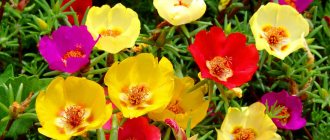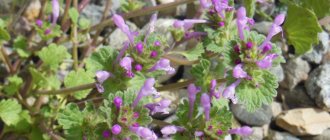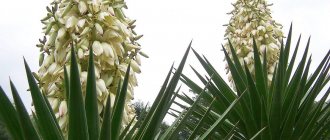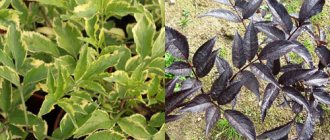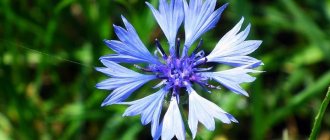The purslane plant (Portulaca), also called dandur, is part of the Portulaceae family. In nature, it is found in the Northern Hemisphere, or more precisely, in areas with a tropical climate. According to data taken from various sources, this genus includes 100–200 species.
Purslane prefers to grow in sandy, moist soil along the banks of various bodies of water, including rivers, and can also be found in fields, orchards and vegetable gardens. The genus name comes from the word “portula”, which is translated from Latin as “small gate, little gate”, this is due to the fact that the seed pod of the plant opens up like miniature doors. In middle latitudes, such a flower is called a “rug.” Back in the Middle Ages, purslane was very popular in Europe. However, most often it was grown by the British, and at first they grew it as a garden crop, not a garden crop. Gardeners cultivate only 1 species, namely: large-flowered purslane (Portulaca grandiflora).
Brief description of cultivation
- Landing . Seeds for seedlings are sown in April, and grown seedlings are planted in open soil in June.
- Bloom . It starts in June and ends in mid-autumn.
- Illumination . Needs plenty of bright sunlight.
- Soil . Grows well on rocky or sandy soil, which should be dry and poor.
- Watering . Systematic. Its abundance depends on weather conditions and can vary from scanty to moderate.
- Fertilizer . Does not require fertilizing.
- Reproduction . Seeds.
- Harmful insects . Aphid.
- Disease . It is highly resistant to disease, but can be affected by a disease caused by the fungus Albugo portulaceae.
- Properties . This medicinal plant has an antiparasitic effect.
Features of purslane

In mid-latitudes, purslane is cultivated by gardeners as an annual plant, since it is not able to overwinter in open ground even under cover. The height of the bush is no more than 0.3 meters. The root of the flower is branched and spindle-shaped. The brown shoots are succulent and branched, they are decorated with fleshy leaf plates that are hollow inside, their shape can be cylindrical or similar to a flattened egg. During flowering, which is observed in June–September, yellow, white and dark red flowers appear on the bush. The lifespan of one flower is only 1 day; by evening it already fades. However, due to the fact that the flowering is very lush, it may seem that it lasts continuously. The fruit is a multi-seeded spherical capsule. In addition to garden purslane, which is cultivated in pots, flower beds, hanging containers and baskets, in the garden you can often find vegetable purslane, or garden purslane, which is considered both a weed and a medicinal herb, as well as a salad plant.
What is this plant?
Heat-loving and annual, it requires annual cultivation - from seeds through the seedling stage, but many gardeners even sell it in pots on March 8: although the plant is not an indoor plant, it looks touching and fun in gift wrapping. In addition, the gifted flower can be planted in the front garden when it gets warmer, and by autumn, collect the seeds from the box to grow further. This plant is from North and South America, but in its wild form it can only be found there, and in Southern Europe, where it has long been refined and new varieties have been bred, it is an indispensable attribute of alpine slides in beautiful home parks.
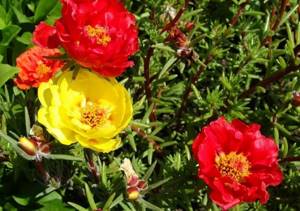
Growing purslane from seeds

Sowing
Most gardeners believe that it is most convenient to grow purslane through seedlings. However, gardeners differ in their opinions on when it is best to start sowing seeds. Some argue that sowing seeds should be done in the last days of February or the first days of March, but in this case the seedlings will need additional lighting. Other equally experienced gardeners are confident that there is no need to rush, and it is better to sow purslane in April, since at this time the daylight hours are already longer, and young plants have enough natural light.
Before you start directly sowing purslane, you need to prepare a suitable substrate for this. The fact is that any ready-made soil mixture sold in a specialized store contains peat, which helps slow down the germination of the seeds of a given plant. To prepare a suitable substrate, combine garden soil with sand in a ratio of 1:5. Mix everything well and disinfect the mixture by heating it in the oven. Take a low container with holes at the bottom for drainage, and place a layer of small expanded clay or gravel in it. Next, a disinfected substrate is poured in, which is spilled with melt water (you can use well-settled water). Distribute the seeds evenly over the surface of the soil mixture, the distance between them should be about 10 mm; this is very convenient and easy to do with a moistened toothpick. The seeds are not sprinkled with substrate on top, but are only slightly pressed into the soil mixture. Then a frame is made over the container, onto which the film is stretched, as a result you will get a mini-greenhouse. It is transferred to a well-lit place in which the air temperature does not drop below 22 degrees. However, purslane germinates best at a temperature of about 30 degrees.
PURSLANE. SOWING PORTULAC SEEDS. REVIEW OF SPROODS. SEASON 2019
Seedling care

If everything is done correctly, then the first seedlings should appear after 7–15 days, immediately after this the shelter is removed from the container. Further care of the seedlings comes down to systematic watering through a tray; for this, well-settled water is used. If you see that the seedlings are beginning to actively stretch, this means they do not have enough light. In this case, it is recommended to provide the seedlings with additional lighting. To do this, it is illuminated with fluorescent lamps in the morning for a couple of hours, and artificial light is also turned on for several hours in the evening. You can also use a simple table lamp for additional lighting. If the day turns out to be cloudy, then the lamps are not turned off throughout the day. However, if sowing is carried out in April, and the seedlings are located on a south-facing window, then they will not need additional lighting.
Picking
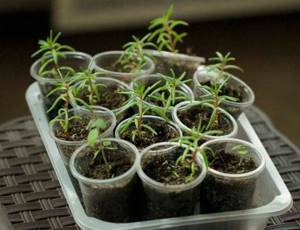
After the plants have formed the first pair of true leaf blades, they will need to be picked. To do this, take small cups, reaching from 70 to 80 mm in diameter, and plant three seedlings in them at once, and try to keep the earthen lump on the roots. And 7 days after they have completely taken root, they are fed for the first time using complex mineral fertilizer. After this, the bushes are fed regularly once every 1–1.5 weeks until transplanted to a permanent place.
Planting purslane in open ground

What time to plant
Purslane is planted in open ground around the first half of June, when the threat of return frosts has passed. There is no point in doing this earlier, since if it is colder than 10 degrees outside, the leaves will begin to fly off the bushes.
To plant such a plant, choose a well-lit and elevated area. Remember that if you plant such a flower even in slight partial shade, it will not bloom. And if a place is chosen for planting in a lowland, where there is often stagnation of water, or where groundwater is located very close to the surface of the site, then the roots of the bushes may rot, which will lead to the death of the purslane. Sandy, poor soil is best suited for growing such a flower, but if the bushes are planted in fertile soil, then they will begin to actively grow green mass to the detriment of flowering.
Landing rules
It is recommended to plant in open soil only after the plants have formed 10 to 15 true leaf blades and several buds. When planting seedlings, it should be taken into account that the distance between the bushes should be at least 15–20 centimeters. After planting the plants in the ground, they are provided with daily watering for the first two or three days, especially if the weather is dry. The first flowers on the plant will appear just 6–7 weeks after the seedlings appear.
Caring for purslane

For normal growth and development, purslane grown in open ground requires systematic watering. Despite the fact that its leaves can retain moisture, if the bushes are watered at the wrong time, this will have an extremely negative effect on flowering. This flower will not need any weeding, fertilizing, pruning throughout the entire growing season, and you will not have to loosen the surface of the soil near the bushes. Caring for purslane comes down to timely watering.
Purslane - GROWING CARE
Diseases and pests
Even a novice gardener can grow purslane, and even someone who doesn’t have enough time to care for flowers can do it. There is also nothing difficult in growing terry purslane, since sowing and caring for it is no different from cultivating large-flowered or garden purslane.
A gardener rarely has problems with such a flower, because it is highly resistant to both diseases and harmful insects. But in those years when a large number of aphids attack the gardens, purslane may also suffer from them. In order to get rid of such a sucking pest, experts advise resorting to the help of an insecticidal preparation. For example, Actellik effectively fights aphids, the solution of which must be used to treat purslane; if necessary, re-spraying is carried out after 7 days.
Quite rarely, but still, purslane can infect the fungus Albugo portulaceae. In this case, the stems of the diseased plant become deformed, and spots form on its foliage. All affected parts will need to be pruned, after which the bushes are treated with a copper-containing fungicidal agent.
Purslane as a plant
The name purslane comes from the Latin word “gate (portula).” This word is from the same category as Portugal and the portal. In the 17th century, a plant from the genus purslane was one of the most popular garden crops in Europe. It first came to France, but the British had the greatest preference for its use. This is one of the many plants that were undeservedly forgotten after the fall of the Roman Empire, but then they remembered it again and began to grow it. In the time of Hippocrates, purslane was used as a remedy for insomnia, poisonous snake bites, and used to treat wounds, and the Arabs in the Middle Ages considered purslane a blessed plant.
The genus Purslane has about 200 species of plants, including annuals, perennials, and even succulents, but only grandiflora purslane is grown, which in South America was a perennial creeping plant, and is now common as an annual garden ornamental crop. It is widely used in flower beds, borders, alpine slides, and is readily planted on balconies, in window boxes, outdoor vases and rosettes. Only with the help of this plant can you decorate an entire pedestrian square with huge flower beds, because its flowers are simple, five-petaled, with a fused corolla, double and even cultivars with a corolla of two colors.
We also recommend reading:
16 most popular indoor plants Physalis: description of species and varieties, technology for growing from seeds Spruce in landscape design: the best ornamental varieties and characteristics of cultivation Kalanchoe: description of types and characteristics of care at home
Care after flowering
Collecting seeds

Regularly pick off all the flowers that have begun to fade from the bushes and remember that if they dry out, then because of them you will not be able to promptly notice the ripe fruit, which can open at any time and its seeds fall to the ground. In warm, dry weather after pollination, seed maturation will be complete in about 15 days. But if it is quite cool outside in summer and autumn, then seed ripening can take 30 days. In addition, you need to take into account the fact that the seeds that you have just collected will become viable only with the onset of next spring, but they retain good germination for 3 years.
Wintering
In mid-latitudes, garden purslane freezes in open ground in winter. In this regard, in the autumn, when the bushes have faded, they are dug up and the soil on the site is dug up. When starting to grow purslane, remember that it reproduces well by self-sowing. Therefore, by planting it just once, you can admire its spectacular flowering every year.
Useful properties of purslane

Purslane was known as a medicinal plant back in the times of Galen and Hippocrates. In those days, people were sure that the seeds of such a plant helped cleanse the body, and its leaves were used as an antidote for snake bites. A paste was made from the leaf blades, which was used to relieve swelling from the eyes, and it was also taken orally with wine, which helped eliminate pain in the bladder, as well as cure a sore stomach. And Arab healers combined finely chopped leaves of such a plant with wine and used the resulting mixture to relieve erysipelas, remove warts and treat acne.
Today, the antiparasitic properties of this flower are widely used in official medicine, and doctors also advise those who suffer from mild diabetes to include it in their diet.
Purslane cultivated
Despite the variegated species diversity, this plant in its cultivated form is found in only two varieties: garden and ornamental. The garden variety (dandur or flea beetle) is not popular among gardeners because they mistake it for a weed. For gardeners, its flowers, small and yellow, are too inexpressive. Its shoots are dark crimson in color, but they usually lie on the ground, and only the flowering part is raised. The leaves of the garden purslane are beautiful, but the garden purslane is not a plant for flower beds, because they only stand out well in the spring.
The value of a garden variety is in the healing substances that make up its composition. They give the shoots an exotic, slightly pungent taste, but are used not so much for food as for their medicinal properties. Purslane juice lowers blood sugar and cholesterol levels, and medications in which it is used eliminate inflammation in the bladder, treat arthritis, difficult-to-heal wounds, and help with diseases of the liver, kidneys, and eyes. In folk medicine it is known as an anti-inflammatory, diuretic, wound-healing plant.
An ornamental variety, whose homeland is Chile, Argentina, Brazil, Uruguay, gardeners conditionally divide it into three groups according to the type of flowering:
- varieties with simple five-petal flowers;
- semi-double varieties (Sunny Princess);
- varieties with double flowers (Mango, Long Summer, Hybrid Cherry, Hybrid Cream, Flamenco).
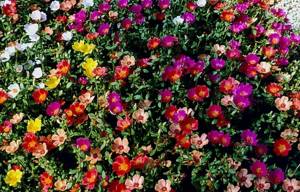
Purslane flowers come in a variety of shades, which is why they are now becoming increasingly widespread. Of all the varieties, only Hybrid Cream, Mango and Princely Rug are distinguished by a certain color tone - Hybrid Cream with flowers of a yellowish-cream color, Mango blooms with intense coral-orange, and Princely Rug, spreading along the ground, is distinguished by corollas of an indescribable crimson-scarlet hue. Terry purslane of the Peacock variety has unique flowers, more lush and ruffled than other varieties, and blooms so intensely from mid-summer. Its flowers come in a wide variety of colors. The Princely Rug is no less famous and is much more widely distributed.
Types and varieties of purslane with photos
Grandiflora purslane (Portulaca grandiflora)

This perennial plant is native to South America, but in mid-latitudes it is cultivated as an annual. The height of such a plant is no more than 0.3 m, since it has lodging shoots. Small fleshy leaf plates have a cylindrical shape. Single flowers, reaching 30–40 mm in diameter, are cup-shaped and can be double or simple. Externally, the flowers are similar to a tea rose, and they can be colored cream, yellow, purple, white, beige or red. There are varieties that have a two-color color. Flowering is long - from June until the last days of October.
Popular varieties:

- Double Mix . Terry variety. Most often found on sale as a mixture of purslane seeds.
- Cherry . The height of this low-growing variety is about 10–12 centimeters; powerful shoots are decorated with double cherry flowers, reaching about 50 mm in diameter.
- Hybrid Cream . Cream double flowers reach about 50 mm in diameter, with a darker center.
- Sunglo . This variety differs from the others in having the largest flowers. They do not close even on a cloudy day, just like the Cloudbeater and Sundance varieties.
Purslane or vegetable purslane (Portulaca oleracea)

The height of this annual plant is about 0.3 m. It reproduces very well by self-sowing. On highly branched shoots there are leaf plates of elongated palmate shape. The yellowish flowers reach from 0.7 to 0.8 cm in diameter. This species grows in groups. Flowering begins in June and ends only at the end of the summer. It is valued for its medicinal properties and good taste.
Purslane flowers - planting and care, growing purslane from seeds in open ground
Common types of purslane
The diverse world of purslane includes more than a hundred species and subspecies of this plant. The plant has different foliage: thin, bright green, fleshy leaves with a gray coating and a red tint in a varied color palette when flowering.
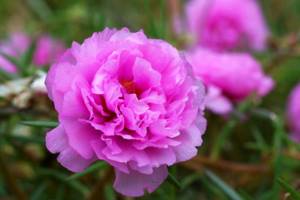
Splendence variety with unusually bright purple-pink petals
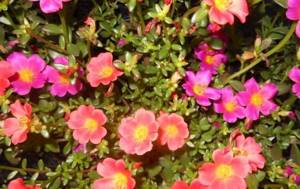
Variety Sunglo with large fleshy shoots and large pink flowers
Large-flowered
A creeping plant with small fleshy leaves up to 30 cm high and large flowers of five petals or double inflorescences up to 3 cm in diameter. The large-flowered species has a rich palette of colors: white, yellow and red with different shades.
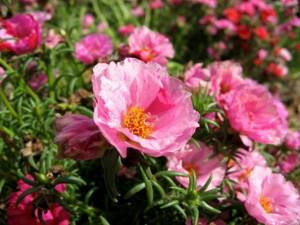
Native to South America, purslane grandiflora is a perennial creeping plant. In our country it is grown as an annual
The plant is edible; young shoots and leaves are eaten, but it is mainly used in landscape design. They are used to decorate alpine slides in gardens and stone borders in city parks and alleys, and are often grown in containers and hanging flowerpots on balconies.
Common varieties: Cherry, Pun and Flamenco.

Cherry variety
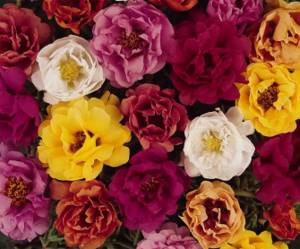
Terry variety Pun
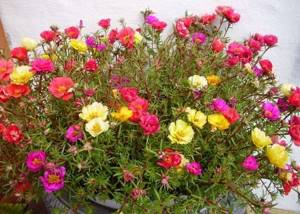
Flamenco variety
Garden
An annual plant 15-30 cm tall, with a thick tubular stem, fleshy leaves and white, yellow, beige and light brown flowers. In the gardens of the southern regions it is grown as a medicinal plant; it often grows along the banks of rivers in rocky areas and reproduces by self-sowing.
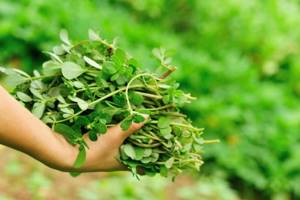
Garden purslane is cultivated all over the world.
Purslane blooms from June to August, and begins to bear fruit in mid-September. Fruits and stems are rich in organic fatty acids, macro and microelements, vitamins, which are a natural antioxidant.
Common varieties: Makovey, Paradox and Firefly.
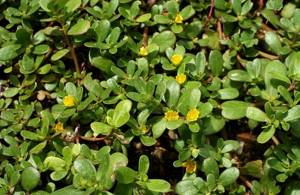
Compared to other species, purslane blooms rather inconspicuously, but it is also grown as a medicinal plant
The common purslane in the photo looks like an original ornamental plant with beautiful flowering.
White-flowered
A bushy, fast-growing variety of purslane species. A bush with a diameter of 40 cm grows within a month and begins to bloom. A distinctive feature of the white-flowered species: a large double inflorescence of white color or with a cream and yellowish tint. Bushes are planted in flower beds as part of compositions or as a separate plant.
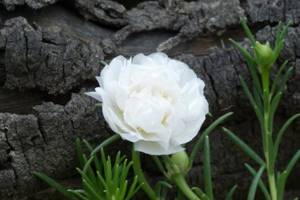
The variety is distinguished by elegant white double flowers.
After looking at a photo of purslane in a flowerbed, it’s hard to refuse this flower in your collection.
